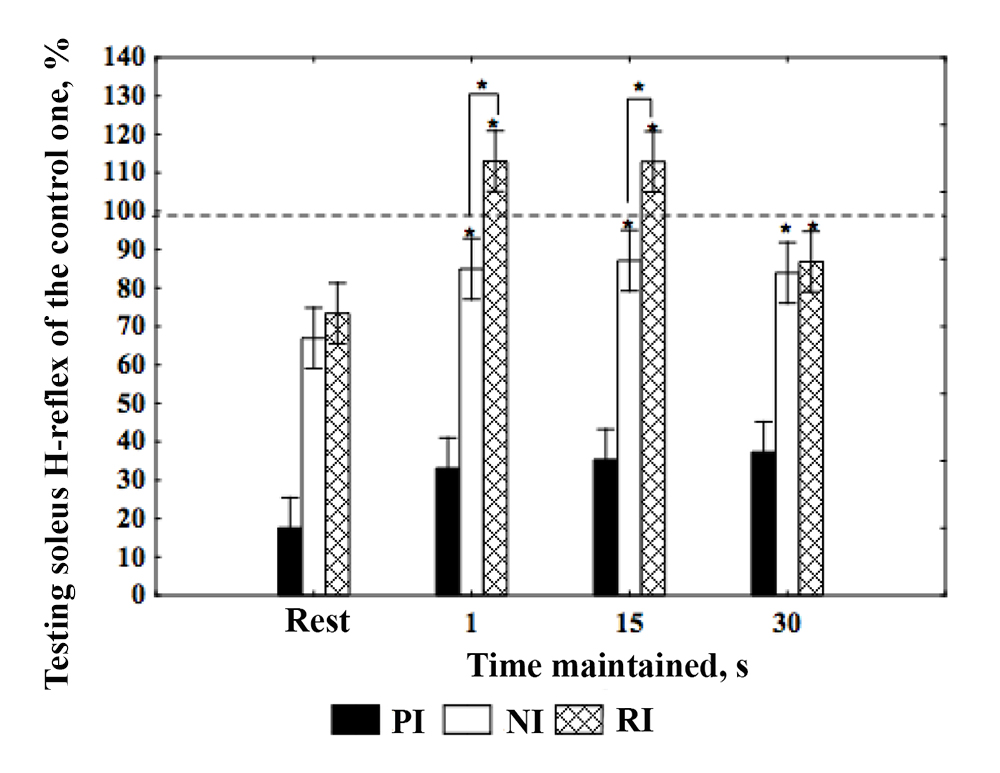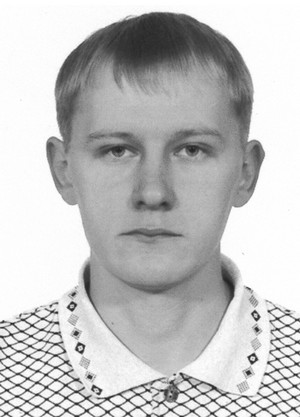Functional features of spinal inhibition during voluntary motor activity in man
Фотографии:
ˑ:
Dr.Biol. A.A. Chelnokov
Ph.D. I.N. Buchatskaya
Velikie Luki State Academy of Physical Culture and Sport, Velikie Luki
Keywords: presynaptic inhibition, nonreciprocal inhibition, reciprocal inhibition, H-reflex, Ia and Ib afferents, α-motoneurons (α-MN), motor activity.
Introduction. The study of inhibitory processes in the central nervous system is important for understanding the nature and mechanisms of human motor behavior. Presynaptic, recurrent, nonreciprocal and reciprocal spinal inhibition in man is being studied in Velikie Luki State Academy of Physical Culture and Sport. It has been established that adaptation to muscular activity of different purposes performed by athletes for a long period of time promotes changes in the intensity of presynaptic inhibition of homonymous and heteronymous Ia afferents [4] and nonreciprocal inhibition of α-MN of the spinal cord [3]. Presynaptic inhibition of Iа afferents increases when various massage techniques are applied [5]. Cases of modulation of nonreciprocal and recurrent inhibition of heteronymous spinal α-MN in sambo athletes and individuals not engaged in sports have been described [6]. Exposure of skeletal muscles to magnetic stimulation carried out against the background of their voluntary contraction during 15 days enhances the leg muscle strength seen in the increase of the maximum angular momentum and the intensity of supraspinal excitatory and inhibitory effects on the spinal cord interneurons [2]. Results of the study of developmental patterns of presynaptic, recurrent, nonreciprocal and reciprocal inhibition when muscles are relatively relaxed and during voluntary movements in people of various age groups indicated the heterochrony in their formation and development at different stages of ontogenesis [7].
The purpose of the research was to study the characteristics of presynaptic inhibition of Ia afferents, nonreciprocal and reciprocal inhibition of α-MN of the soleus muscle (SM) when performing voluntary movements and possible mechanisms of these manifestations. New data obtained as a result of the studies can become a theoretical basis for studying physiological patterns of involvement of cortical and spinal inhibitory neuronal networks that underlie athletes’ motor tasks of varying complexity.
Materials and methods. 45 healthy male subjects aged 22-27 were examined. The subjects performed a 30-second isometric contraction of muscles (plantar flexion of the foot) with a force of 25% of individual maximum voluntary contraction in a sitting position on the multi-joint diagnostic and treatment complex «Biodex Multi-Joint System Pro-3» (USA, 2006). Presynaptic inhibition of soleus Ia afferents was measured using the technique by Y. Mizuno et al. [9], nonreciprocal inhibition of soleus α-motoneurons - by E. Pierrot-Deseilligny et al. [10], and reciprocal inhibition of soleus α-motoneurons - by C. Crone et al. [8]. These types of inhibition were tested in the subjects while at rest and during the isometric contraction at the 1st, 15th and 30th seconds. The inhibitory effect was assessed as percentage ratio of the amplitude of testing H-reflex obtained during a conditioning stimulation in the peripheral nerve to control value. It was posited that greater inhibition of the amplitude of the testing H-reflex of the soleus muscle to the amplitude of the control H-reflex promotes a more pronounced studied type of spinal inhibition. Statistical analysis of the data was performed using the non-parametric method of Kruskal-Wallis Anova by means of Statistica 10.0 software (Statsoft Inc, 2010).
Results and discussion. As seen from the present research, weakening of presynaptic Ia afferents, nonreciprocal and reciprocal inhibition of the spinal α-MN shin muscles took place during the performance of a voluntary isometric movement, as compared to the state of rest. The nature of the detected changes of inhibitory processes was shown in a significant increase in the amplitude of the testing soleus H-reflex during a conditioning peripheral nerve stimulation in the course of a 30-second voluntary contraction of shin muscles compared to the state of rest (Figure 1). For example, when recording presynaptic inhibition while maintaining the static effort the amplitude of the testing soleus H-reflex increased maximally at the 30th second of the effort by 19.76% (Р=0.000) compared to the state of rest, that of the nonreciprocal inhibition - at the 15th second by 20.20% (Р=0.006) and of the reciprocal inhibition - at the 1st second by 26.15% (Р=0.000). The observed weakening of inhibitory processes while performing voluntary static movements is consistent with the data of many authors [7, 8, 9, 10 et al], in whose works the neurophysiological mechanisms of presynaptic, nonreciprocal and reciprocal inhibition of shin muscles at the beginning of a static effort were studied. According to the authors, descending brain systems and ascending afferent systems have a huge impact on the weakening of spinal inhibitory processes while performing voluntary movements.
Data obtained during study of presynaptic inhibition while performing voluntary movements indicated that intensity of this type of inhibition remains constant throughout all 30 seconds of the performance (Figure 1). Suppression of the amplitude of the testing H-reflex in this case remained practically unchanged and ranged from 66.88% to 62.68% (Р=1.000). Similar results were obtained when evaluating nonreciprocal inhibition in the course of voluntary contraction. In this case suppression of the amplitude of the testing H-reflex throughout the 30-second static effort ranged from 16.05% to 12.85% (Р=1.000).
Results of the study of reciprocal inhibition during isometric contraction in the lower leg muscles showed that reciprocal relief on motor neuron pool of the soleus muscle manifested during a 15-second effort (Figure 1). Amplitude relief of the testing H-reflex remained practically unchanged during 15 seconds of the effort and ranged from 13.01% to 12.90% (Р=1.000). By the 30th second of maintained effort the reciprocal relief inverted to reciprocal inhibition of α-MN of the soleus muscle to the baseline values recorded while at rest. The suppression of the amplitude of the testing H-reflex by the 30th second of the static effort was 13.14%.

Figure 1. Amplitude of the testing soleus H-reflex of the control reflex at rest and during a static effort with the force of 25% of the maximum voluntary force, %: PI - presynaptic inhibition, NI - nonreciprocal inhibition, RI - reciprocal inhibition; P<0.01* - significant difference between the intensity of PI, NI and RI (Kruscal-Wallis Anova).
According to comparative analysis of group average values of the amplitude of the testing H-reflex of the soleus muscle of the control reflex during a static effort presented in Figure 1, the greatest intensity of presynaptic inhibition compared with the nonreciprocal and reciprocal inhibition was recorded while performing voluntary movements during 30 seconds (Р=0.000). The obtained results suggest that in the process of controlling voluntary movements descending flows from the corticospinal tract and ascending flows from Ia afferents of the anterior tibial muscle have a greater inhibitory impact on the spinal interneuronal networks of presynaptic inhibition. This is consistent with the data on the modulation of induced muscle responses in subjects adapted to motor activity of various nature [1].
Lower intensity of nonreciprocal inhibition was recorded while performing voluntary contractions for 15 seconds (Р=0.000, Figure 1). The weakest intensity of reciprocal inhibition (Р=0.000) was observed during 15 seconds of performed motor task which reached the intensity of nonreciprocal inhibition by the 30th second (Р=1.000, Figure). The detected weak and the weakest intensity of nonreciprocal and reciprocal inhibition of α-MN while performing voluntary movements probably has to do with the weakening of excitatory supraspinal and peripheral impacts of soleus Ia and gastrocnemius Ib afferents on inhibitory interneurons of the spinal cord, which leads to increased relieving impacts on the motor neuron pool of the soleus muscle.
Conclusions. Weakening of the studied processes of spinal inhibition compared to the state of relative muscular rest takes place during motor activity of the lower leg muscles. Voluntary movements performance is accompanied by the most pronounced increase of presynaptic inhibition of Ia afferents of foot flexor and weakening of nonreciprocal and reciprocal α-motoneurons inhibition. In the course of voluntary movement presynaptic inhibition must be actively regulating the excess afferent input to α-motoneurons of agonist and antagonist lower leg muscles, accelerating nonreciprocal and reciprocal inhibitory effects rendered on them, providing normal motor activity in man.
References
- Andriyanova, E.Yu. Mekhanizmy dvigatel'noy plastichnosti spinnomozgovykh nervnykh tsepey na fone dolgovremennoy adaptatsii k sportivnoy deyatel'nosti (Mechanisms of plasticity of spinal nerve circuits on the background of long-term adaptation to sports activity) / E.Yu. Andriyanova, O.V. Lanskaya // Fiziologiya cheloveka. – 2014. – V. 40. – № 3. – P. 73–85.
- Gorodnichev, R.M. Vliyanie elektromagnitnoy stimulyatsii na pokazateli myshechnoy sily (The influence of electromagnetic stimulation on muscle strength indices) / R.M. Gorodnichev et al. // Fiziologiya cheloveka. – 2014. – V. 40. – № 1. – P. 76–81.
- Gorodnichev, R.M. Issledovanie tormoznykh protsessov v tsentral'noy nervnoy sisteme pri izometricheskom myshechnom sokrashchenii (Study of inhibitory processes in central nervous system during isometric muscle contraction) / R.M. Gorodnichev et al. // Vestnik Tverskogo gosudarstvennogo universiteta. – 2008. – № 8. – P. 13–18.
- Gorodnichev, R.M. Presinapticheskoe tormozhenie al'fa-motonejronov spinnogo mozga cheloveka pri adaptatsii k dvigatel'noy deyatel'nosti raznoy napravlennosti (Presynaptic inhibition of alpha motor neurons of spinal cord during man's adaptation to motor activity of different purposes) / R.M. Gorodnichev, R.N. Fomin // Fiziologiya cheloveka. – 2007. – № 2 (33). – P. 98–103.
- Povareshchenkova, Yu.A. Modulyatsiya presinapticheskogo tormozheniya a-motonejronov spinnogo mozga pri deystvii mekhanorazdrazhiteley razlichnoy intensivnosti (Modulation of presynaptic inhibition of α-motor neurons of the spinal cord under influence of mechanical stimuli of varying intensity) / Yu.A. Povareshchenkova, D.A. Petrov // Fiziologiya cheloveka. – 2008. – № 1 (34). – P.108–113.
- Chelnokov, A.A. Vliyanie urovnya dvigatel'noy aktivnosti na modulyatsiyu neretsiproknogo i vozvratnogo tormozheniya spinal'nykh α-motonejronov u lits yunosheskogo vozrasta (Influence of level of motor activity on modulation of nonreciprocal and recurrent inhibition of spinal α-motor neurons in young people) / A.A. Chelnokov, I.N. Buchatskaya // Pedagogiko-psikhologicheskie i mediko-biologicheskie problemy fizicheskoy kul'tury i sporta. – 2010. – № 4(17). – P. 78–85. – URL: http://kamgifk.ru/magazin/4_10/17.pdf
- Chelnokov, A.A. Vozrastnye osobennosti spinal'nogo tormozheniya cheloveka pri proizvol'noy dvigatel'noy aktivnosti myshts goleni (Age features of spinal inhibition at voluntary motor activity of leg muscles in man) / A.A. Chelnokov, R.M. Gorodnichev // Teoriya i praktika fizicheskoy kul'tury. – 2013. – № 11. – P. 80.
- Crone, C. Reciprocal Ia inhibition between ankle flexors and extensors in man / C. Crone et al. // J. Physiol. Lond. – 1987. – V. 389. – P. 163-185.
- Mizuno, Y. Reciprocal group I inhibition of triceps surae motoneurones in man / Y. Mizuno et al. // Journal of Neurophysiology. – 1971. – V. 34. – P. 1010-1017.
- Pierrot-Deseilligny, E. The Circuitry of the Human Spinal Cord: Spinal and Corticospinal Mechanisms of Movement / E. Pierrot-Deseilligny, D. Burke. – United States: Cambridge University Press, 2012. – 606 P.
Corresponding author: gorodnichev@vlgafc.ru


